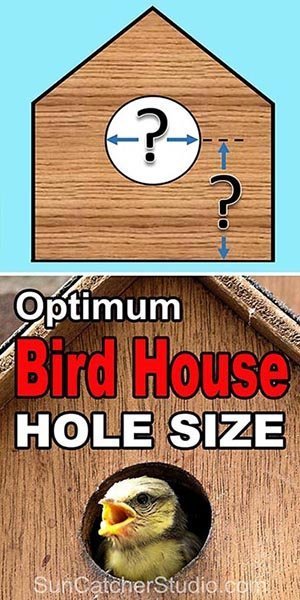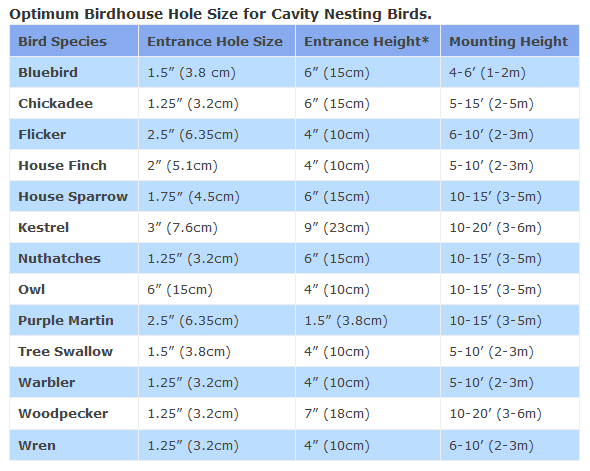Bird House Hole Size (Best Dimensions)
When building a birdhouse or nestbox, the hole size (entrance) is one of the most important decisions you will need to make. Do you know that the diameter of the hole determines which birds will fit into the house and which birds will leave it alone? If the entrance hole is too large you might find less desirable birds are using your birdhouse.

If you are not sure which types of birds you want to attract, go with a larger hole size. This is because birds in general will use a bird house with an entrance hole larger than required. However, the birds will be at more risk from predators such as European starlings which are known for killing nestlings. Learn about the best locations for birdhouse placement and cleaning your birdhouse.
Below are some optimum hole sizes for common cavity nesting birds. That is, birds that build nests and lay eggs inside a cavity or sheltered chamber.
Optimum Birdhouse Hole Size for Cavity Nesting Birds.
| Bird Species | Entrance Hole Size | Entrance Height* | Mounting Height |
| Bluebird | 1.5” (3.8 cm) | 6” (15cm) | 4-6’ (1-2m) |
| Chickadee | 1.25” (3.2cm) | 6” (15cm) | 5-15’ (2-5m) |
| Flicker | 2.5” (6.35cm) | 4” (10cm) | 6-10’ (2-3m) |
| House Finch | 2” (5.1cm) | 4” (10cm) | 5-10’ (2-3m) |
| House Sparrow | 1.75″ (4.5cm) | 6” (15cm) | 10-15’ (3-5m) |
| Kestrel | 3” (7.6cm) | 9” (23cm) | 10-20’ (3-6m) |
| Nuthatches | 1.25” (3.2cm) | 6” (15cm) | 10-15’ (3-5m) |
| Owl | 6” (15cm) | 4” (10cm) | 10-15’ (3-5m) |
| Purple Martin | 2.5” (6.35cm) | 1.5” (3.8cm) | 10-15’ (3-5m) |
| Tree Swallow | 1.5” (3.8cm) | 4” (10cm) | 5-10’ (2-3m) |
| Warbler | 1.25” (3.2cm) | 4” (10cm) | 5-10’ (2-3m) |
| Woodpecker | 1.25” (3.2cm) | 7” (18cm) | 10-20’ (3-6m) |
| Wren | 1.25” (3.2cm) | 4” (10cm) | 6-10’ (2-3m) |
*Entrance Height – location of hole above floor.
One or Two Entrance holes?
Believe it or not, you might want to consider adding more than one entrance hole to your birdhouse. Below are some potential advantages of birdhouses with two entrance holes.
- Both adult birds can feed the young ones at the same time. Otherwise, one adult bird might waste time and energy flying around until the entrance hole is available.
- A second entrance will help avoid the strongest chick dominating access.
- If a predator (such as a snake) gets into the nest, at least the adult birds can escape.
- A second entrance hole helps improve ventilation – allowing better air circulation on warm days.
Where to mount the birdhouse.
To attract nesting birds, it is important to mount or hang the birdhouse in the ideal location. Below are some factors to consider when deciding on where to place a birdhouse.
Birdhouse Location.
Purple martins and bluebirds prefer birdhouses that are in open areas. Most other birds prefer concealed areas that help camouflage the birdhouse. The parents like branches nearby so they can keep an eye over their family.
Birdhouse height.
In general, the higher the bird house the more protection the house provides from cats and other predators. The chart above list the recommended heights for mounting birdhouses for various bird species.
Birdhouse Perch.
Learn the advantages and disadvantages of a Birdhouse perch.
Image Version of Birdhouse Hole Size

Related Articles on Bird Houses, Bird Feeders & More
Use these free DIY bird house plans and bird feeder plans to attract bluebirds, chickadees, flickers, finches, house sparrows, hummingbirds, kestrel, nuthatches, owls, purple martins, swallows, thrushes, warblers, woodpeckers, wrens, and other birds to your garden.



